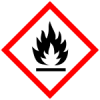Coalition status
Fairtrade Yellow
This list contains 110 pesticides. The list is valid as of January 2018.
Pesticides which are flagged as being hazardous and should be only used with…
FSC ProhibitedThe Forest Stewardship Council (FSC) is an international non-profit, mission –driven, multi-stakeholder organization founded in 1994 to promote…
GCP-Phase-Out 2026Use of pesticides in the Phase-out List are reduced through use of Integrated Pest Management and phased out by 2030, if feasible. This includes…
Rainforest Risk MitigationSAN Risk MitigationThe SAN List of Pesticides for Use with Risk Mitigation is a product of U.S.A. public funding and the intellectual property of the analysis process…
UEBT Risk MitigationThe use of the Risk Mitigation Agrochemicals is discouraged as they are known to bear significant human health and environmental risks. Where these…
Details
Type: Pesticide
Use: Nematicide, Bactericide
Example applications: Vegetables including peppers, zucchini, eggplant;Fruit including melon, tomato;Forage crops including grasses and legumes;Fibre crops;Nursery crops
Example pests controlled: Most species of cyst and free-living nematodes;Corky ringspot (Tobacco rattle virus)
Mode of action: Soil fumigant that penetrates into the nematodes via mouth and cuticle
Source: PPDB
Toxicty
GHS safety labels
About Globally Harmonized System of Classification and Labelling of Chemicals (GHS)
From Wikipedia: The Globally Harmonized System of Classification and Labelling of Chemicals (GHS) is an internationally agreed-upon standard managed by the United Nations that was set up to replace the assortment of hazardous material classification and labelling schemes previously used around the world. Core elements of the GHS include standardized hazard testing criteria, universal warning pictograms, and harmonized safety data sheets which provide users of dangerous goods with a host of information. The system acts as a complement to the UN Numbered system of regulated hazardous material transport. Implementation is managed through the UN Secretariat. Although adoption has taken time, as of 2017, the system has been enacted to significant extents in most major countries of the world.[1] This includes the European Union, which has implemented the United Nations' GHS into EU law as the CLP Regulation, and United States Occupational Safety and Health Administration standards.
- H226

Flammable liquid and vapour
Class: Flammable
Subclass: Liquids - H301

Toxic if swallowed
Class: Acute Toxicity
Subclass: Oral - H304
May be fatal if swallowed and enters airways
Class: Aspiration Hazard - H311

Toxic in contact with skin
Class: Acute Toxicity
Subclass: Dermal - H315

Causes skin irritation
Class: Corrosion/irritation
Subclass: Skin - H317

May cause an allergic skin reaction
Class: Sensitization
Subclass: Skin - H319

Causes serious eye irritation
Class: (Corrosion)Damage/irritation
Subclass: Eye - H332

Harmful if inhaled
Class: Acute Toxicity
Subclass: Inhalation - H335

May cause respiratory irritation
Class: STOT-respiratory irritation
Subclass: Single exposure - H400

Very toxic to aquatic life
Class: Aquatic
Subclass: Acute - H410

Very toxic to aquatic life with long lasting effects
Class: Aquatic
Subclass: Chronic
